The LG G5 Review
by Matt Humrick on May 26, 2016 8:00 AM EST- Posted in
- Smartphones
- Snapdragon
- Qualcomm
- LG
- Mobile
- Snapdragon 820
- LG G5
GPU Performance
The LG G5 uses Qualcomm’s latest Adreno 530 GPU. We officially know next to nothing about its low-level architecture; Qualcomm remains tight-lipped about its GPUs, turning them into intriguing black boxes. From the few shreds of information the company has shared over the years, along with our detailed measurements, we know that improving ALU performance has been a top priority for the past few generations. This emphasis has given Adreno GPUs an advantage in games that make heavy use of pixel shading and post-processing, but ARM’s Mali and Imagination’s PowerVR GPUs still held an edge in vertex processing in some configurations. Our initial look at the Adreno 530 showed that it’s a more balanced architecture, with big improvements to vertex processing that alleviate the biggest handicap for past Adreno GPUs.
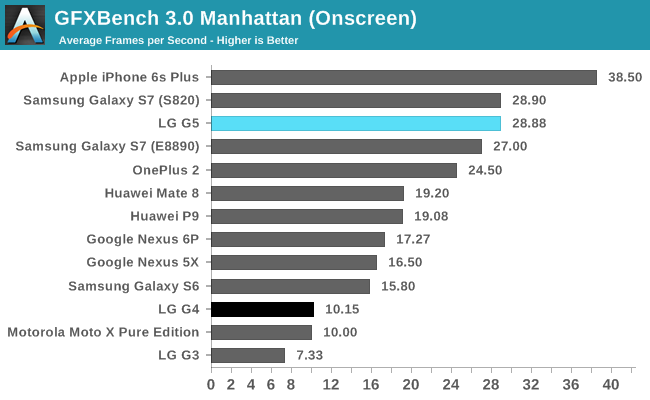
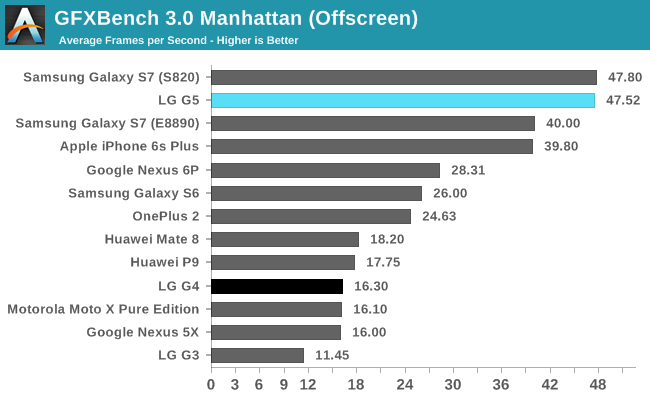
GFXBench 3.0 uses an OpenGL ES 3.0 game engine that stresses lighting and pixel effects. In the offscreen results, Qualcomm’s Adreno 530 leads the pack. The G5 outperforms the previous generation Adreno 430 in the Nexus 6P by 68% and is almost three times faster than the Adreno 418 in the G4.
Even when rendering onscreen at 1440p, the Adreno 530 in the G5 and Galaxy S7 outpace the OnePlus 2’s Adreno 430 rendering at a lower 1080p resolution. The G5 also maintains its nearly 3x advantage over the G4, a significant jump for just one generation.
In the previous section, we routinely saw Huawei’s Mate 8 and P9 near the top of our performance charts; however, their GPU performance is not at the same level. While both use ARM’s latest Mali-T880 GPU, they employ fewer cores (four) that ramp to a high max frequency. The Exynos 7420 SoC in Samsung’s Galaxy S6 uses the previous generation Mali-T760 GPU in an eight core configuration with a slightly lower max clock. With more ALUs and twice as many texture units, the Exynos 7420 offers better GPU performance than the Kirin 950 and 955 in Huawei’s flagships.
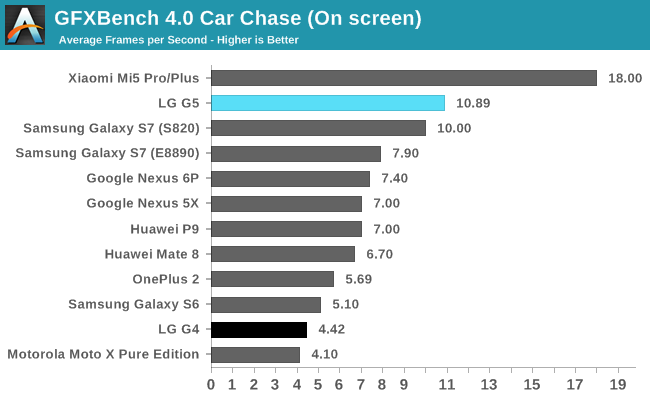
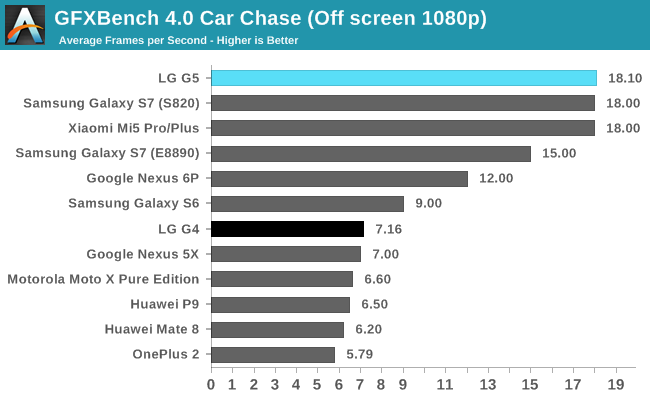
GFXBench 4.0 Car Chase is Kishonti’s latest high-level game engine that uses OpenGL ES 3.1 with Android Extension Pack. Like the earlier Manhattan test, it uses deferred rendering and dynamic lighting, but it also adds visual effects such as HDR tone mapping, motion blur, and bloom using geometry and compute shaders. Perhaps the biggest change is the inclusion of hardware tessellation.
With its heavy reliance on compute shaders, it’s not surprising to see the Adreno 530 GPUs out front once again in this test. The Mali-T880MP12 GPU in the Galaxy S7’s Exynos 8890 SoC comes within 20% of the G5’s Adreno 530, but this margin increases to 38% when running onscreen. The Nexus 6P’s newer graphics driver helps boost performance over the OnePlus 2 by about a factor of two.
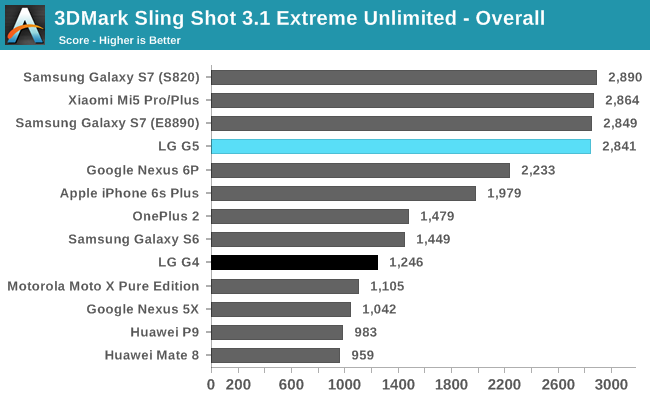
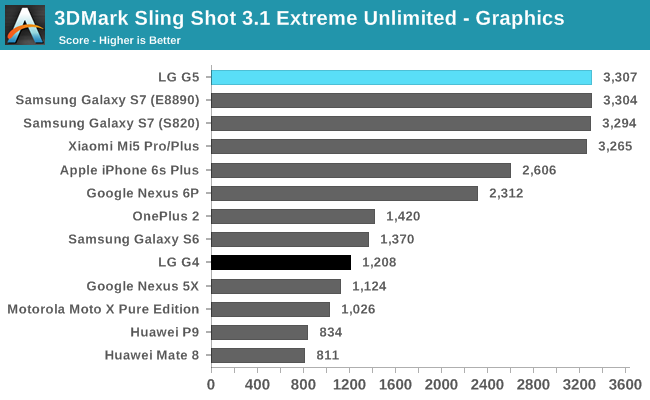
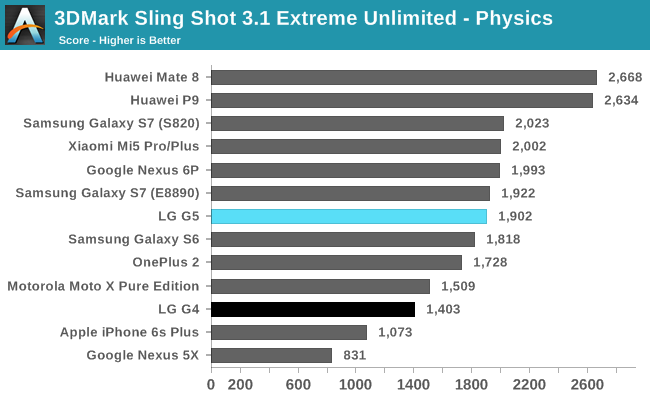
We recently moved from 3DMark’s Ice Storm Unlimited, which uses an OpenGL ES 2.0 graphics engine and renders offscreen at 1280x720, to 3DMark’s newer Sling Shot 3.1 Unlimited, which uses either OpenGL ES 3.1 on Android or Metal on iOS and renders offscreen at a 2560x1440 QHD resolution.
Once again the G5 does well overall thanks to its strong performance in the graphics tests. It’s interesting to see the Exynos 8890 version of the Galaxy S7 perform exactly the same as the Snapdragon 820 phones in the graphics test after trailing in GFXBench 4.0 Car Chase.
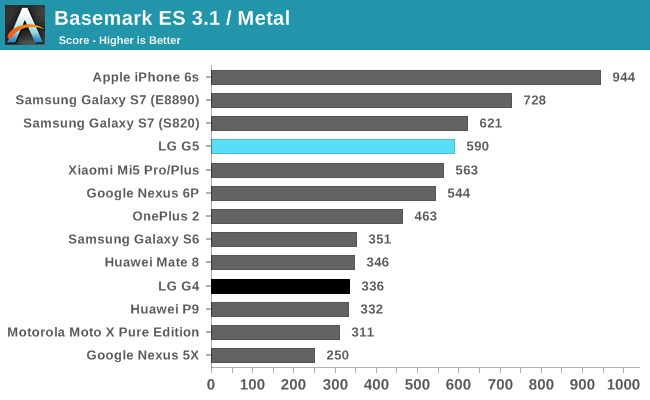

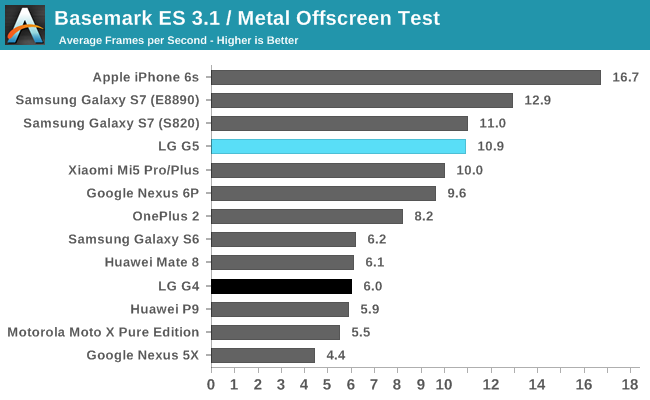
Basemark ES 3.1 is another test that uses either OpenGL ES 3.1 on Android or Metal on iOS. It’s rendering pipeline and feature set are similar to GFXBench 4.0 Car Chase, but it omits tessellation. There’s both on onscreen and offscreen test, with the offscreen test rendering at 1080p.
Here we see the Galaxy S7 and its Exynos 8890 SoC jump ahead of the G5 and the other Snapdragon 820 phones for the first time. Because this is such a complex test with so many graphical features enabled, we cannot gain any insight into particular strengths and weaknesses of each GPU architecture.
Based on these tests it’s clear the G5 offers a significant increase in peak GPU and gaming performance over the G4. It’s Adreno 530 GPU is two to three times faster than the G4’s Adreno 418 and about 50% faster than the Nexus 6P’s Adreno 430 in most tests. The G5 performs better than the Exynos 8890 version of the Galaxy S7 in the two GFXBench tests, but falls a little behind in Basemark ES 3.1. Neither the G3 nor the G4 could match the peak gaming performance of flagship phones in their day, but the G5 is the first in LG’s G Series to get a GPU powerful enough to drive its QHD display. Peak performance is great for benchmarks and bragging rights, but sustained performance, which we’ll examine in the next section, is the real metric that affects the overall gaming experience.










92 Comments
View All Comments
osxandwindows - Thursday, May 26, 2016 - link
finally!.zeeBomb - Thursday, May 26, 2016 - link
Damn... This review surprised me! Still won't get it, but nice to have itv finally doneAlexey291 - Thursday, May 26, 2016 - link
As usual their reviews are so late that the devices of the current generation have been bought already by those who was planning to buy them.Unless it's an iPhone ofc. That shit gets a review in a week
tuxRoller - Thursday, May 26, 2016 - link
First, that's probably an exaggeration.Second, there are only a couple of iphone launches every year, at most. That's a much easier load to track compared to the swarm of android devices that dribble out over the year (with a plurality released around March, tbh).
marcolorenzo - Sunday, May 29, 2016 - link
So what? Why does it matter how many Android devices there are compared to iPhones? The OS has nothing to do with reviewing a phone, that kind of segregation makes absolutely no logical sense. Of course, during this period when several manufacturers decide to release their phones at the same time, the workload of reviewers would suddenly spike but it still doesn't excuse the delays they have during other times of the year. Let's just face facts. IPhones, like sex, sells. Of course they would double down and getting a review of the latest iPhones out the door, they get more viewers that way.tuxRoller - Sunday, May 29, 2016 - link
It matters because the person I responded to mentioned how iPhone reviews come out relatively quickly. I responded by explaining my understanding of the situation, which is that phones are, in a practical sense, categorized by their OS. Specifically with regards to apple, they are there only ones who produce ios phones, and only make, at most, a couple of releases a year. What's more, those particular phones are the most purchased of any particular phone so interest is highest in them.For Android, the sales distribution is far more diffuse, and Samsung, for one, has at least a couple major releases every year.
When you have a finite amount of man power you have to distribute it in a way that provides the most benefits.
As for their delays during other times, there were, iirc, mitigating circumstances(reviewers were sick, schoolwork, etc). If you have actual knowledge that indicates otherwise I'd be interested.
anoxy - Monday, May 30, 2016 - link
Wait, are you really that dense? You answered your own question but you're still throwing a hissyfit?More phone releases = more workload = increased delays in using (adequately) and reviewing every phone.
There are usually two iPhones, and they likely receive review units well in advance and thus have plenty of time to use them. And yes, there is a greater incentive to review an insanely popular device like the iPhone. Why does that upset you?
Ranger1065 - Friday, May 27, 2016 - link
Nicely written article, but even, "better late than never" barely applies. Anandtech takes another GIANT step, towards obsolescence...Alex J. - Friday, May 27, 2016 - link
I agree, it's pretty disappointing how more and more "late" all of their reviews are becoming... At this rate, the HTC10 review would probably come at the end of the summer.And yea, "better late than never" phrase is also losing its relevancy - most of the people whom I personally know and who were planning to "upgrade" their Android phones this year have already done so, meaning the "late" reviews like this have lost all relevance to them. But whatever - if Purch Media wants to run Anandtech into the ground - it's their choice.
DiamondsWithaZ - Monday, September 19, 2016 - link
It did haha. The HTC 10 review literally just got posted... The phone has been out for almost 6 months.